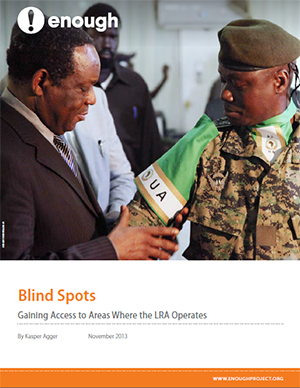
The Ugandan-led and U.S.-supported counter-LRA African Union Regional Task Force, or AU-RTF, has made significant progress in defeating the LRA, with LRA numbers down to roughly 250 core fighters. However, a new Enough Project report argues that further success of the mission is contingent on increased logistical capacity and access to key areas in the Democratic Republic of Congo,or DRC, the Central African Republic, or CAR, and the Kafia Kingi enclave in South Darfur, Sudan—regions that provide safe havens from military pressure and create the opportunity for the LRA to regroup and rebuild their strength.
The report, “Blind Spots: Gaining Access to Areas Where the LRA Operates,” calls on the international community to facilitate a regional agreement allowing the AU-RTF full operational access to all LRA-affected areas. A recommitment to regional cooperation, international financial and logistical support, and U.N. Security Council attention could generate the final push necessary to complete the decade-long fight against the LRA and support the beginning of cross-border security-integration in Central Africa.
Over the past 25 years, the LRA has tormented civilians across Central Africa with attacks and abductions. LRA actions have resulted in the deaths of hundreds of innocent people and the displacement of at least 350,000 civilians. Through the political will of Uganda and the support of U.S. advisors, the AU-RTF has successfully reduced the number of LRA fighters and pushed them into hiding. Despite these efforts, the remaining LRA forces are able to evade military pressure by crossing international borders and inhabiting areas with limited national security forces.
The report asserts that challenges of access differ for the DRC, CAR, and the Kafia Kingi enclave in South Darfur. The LRA maintains permanent camps in the northeastern Orientale province of the DRC, which the Ugandan army has no authorization to enter. In CAR, the alarming destabilization of the country and existence of localized Seleka groups prevent the AU-RTF from conducting operations outside of their base in the southeastern province of Haut-Mboumou. Lastly, while Sudan has shown encouraging signs of cooperation with the Ugandan led forces, access to the Kafia Kingi safe haven has been denied in the past.
Enough Project LRA Field Researcher and author of the report, Kasper Agger, says, “The endgame of removing LRA leader Joseph Kony from the battlefield and neutralizing the LRA is imperiled by the lack of access to wide swathes of Central Africa where the group still hides. Expanded regional cooperation and increased political commitment for the mission are critical to boosting ongoing counter-LRA efforts and bringing a final end to the LRA rebel group.”
Moving forward, the report urges Uganda, DRC, CAR, Sudan, and international actors to commit to the Regional Cooperation Initiative for the Elimination of the Lord’s Resistance Army, which has attempted to increase regional military cooperation, facilitate cross-border operations, and increase political commitments. The realization of these efforts could effectively bring an end to the LRA and provide a roadmap for future African regional security initiatives.

